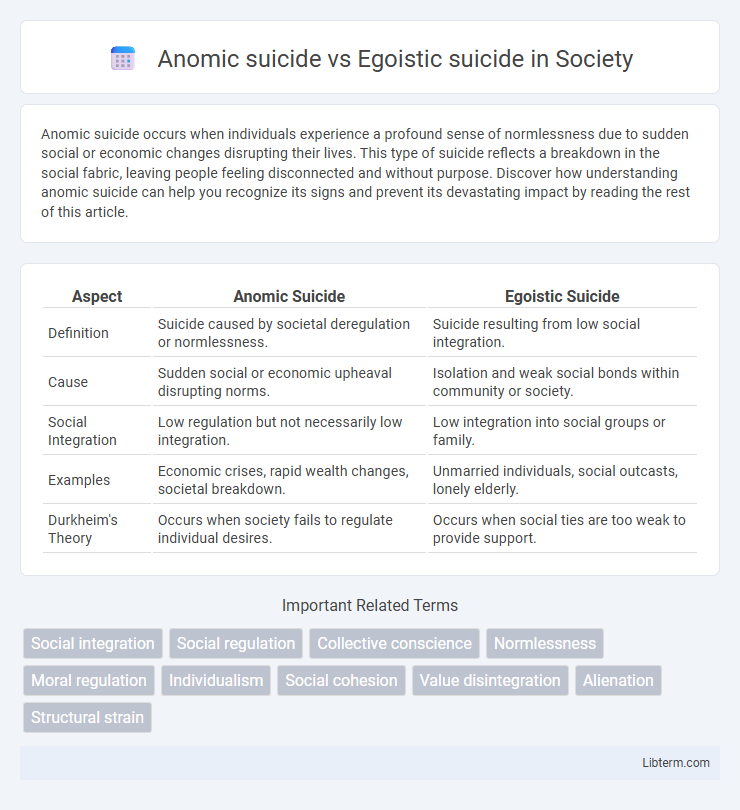Anomic suicide occurs when individuals experience a profound sense of normlessness due to sudden social or economic changes disrupting their lives. This type of suicide reflects a breakdown in the social fabric, leaving people feeling disconnected and without purpose. Discover how understanding anomic suicide can help you recognize its signs and prevent its devastating impact by reading the rest of this article.
Table of Comparison
| Aspect | Anomic Suicide | Egoistic Suicide |
|---|---|---|
| Definition | Suicide caused by societal deregulation or normlessness. | Suicide resulting from low social integration. |
| Cause | Sudden social or economic upheaval disrupting norms. | Isolation and weak social bonds within community or society. |
| Social Integration | Low regulation but not necessarily low integration. | Low integration into social groups or family. |
| Examples | Economic crises, rapid wealth changes, societal breakdown. | Unmarried individuals, social outcasts, lonely elderly. |
| Durkheim's Theory | Occurs when society fails to regulate individual desires. | Occurs when social ties are too weak to provide support. |
Understanding Suicide: An Overview
Anomic suicide occurs when societal norms break down, leading to feelings of aimlessness and despair, often triggered by sudden social or economic changes. Egoistic suicide results from excessive individualism and lack of social integration, where individuals feel isolated and disconnected from their community. Understanding these types reveals how varying degrees of social regulation and integration impact suicide rates and mental health outcomes.
Defining Anomic Suicide
Anomic suicide occurs when individuals face sudden disruptions in social or economic stability, leading to feelings of normlessness and despair. Unlike egoistic suicide, which stems from excessive individualism and social detachment, anomic suicide arises from the breakdown of social equilibrium and the loss of clear societal norms. Emile Durkheim established these concepts, emphasizing that anomic suicide is linked to crises such as unemployment or financial collapse that erode traditional guidance and social regulation.
Defining Egoistic Suicide
Egoistic suicide occurs when individuals feel detached from society due to weak social integration and lack of meaningful connections, leading to feelings of isolation and purposelessness. In contrast, anomic suicide arises from a breakdown in social regulation caused by sudden societal or economic changes, resulting in normlessness. Understanding egoistic suicide highlights the critical role of social bonds in fostering psychological well-being and preventing self-destructive behavior.
Origins of Anomic Suicide: Durkheim’s Perspective
Anomic suicide originates from a state of normlessness or social instability, where rapid social or economic changes disrupt societal norms, leading individuals to feel disconnected and purposeless. Emile Durkheim emphasized that this form of suicide arises when traditional regulation weakens, causing a breakdown in the moral framework that guides behavior. Unlike egoistic suicide, which results from excessive individualism and isolation, anomic suicide reflects a collective crisis of moral regulation impacting individuals' ability to adapt to changing social conditions.
Causes and Triggers of Anomic Suicide
Anomic suicide occurs due to a breakdown in social regulation, often triggered by sudden economic crises, drastic social changes, or personal misfortunes that disrupt an individual's sense of belonging and stability. Unlike egoistic suicide, which stems from excessive individualism and social isolation, anomic suicide reflects a state of normlessness where societal norms fail to guide behavior, leading to feelings of aimlessness and despair. Key causes include rapid wealth loss, unemployment, divorce, or political upheaval that erode social structure and individual purpose.
Causes and Triggers of Egoistic Suicide
Egoistic suicide occurs when individuals feel detached from social groups, lacking a sense of belonging or integration, often triggered by isolation, loneliness, or loss of meaningful relationships. Causes include weakened social ties, exclusion from community activities, and diminished shared values that provide life purpose. This contrasts with anomic suicide, which arises from societal instability and disrupted norms during rapid social or economic change.
Key Differences: Anomic vs Egoistic Suicide
Anomic suicide occurs due to a breakdown of social equilibrium and normlessness, often triggered by sudden economic or social changes, leading individuals to feel disconnected from societal expectations. Egoistic suicide results from excessive individualism and a lack of social integration, where people feel isolated and unsupported by community bonds. The key difference lies in anomic suicide stemming from societal deregulation, whereas egoistic suicide arises from insufficient social integration.
Societal Factors Influencing Each Suicide Type
Anomic suicide occurs when societal norms break down during periods of economic or social upheaval, leading to feelings of aimlessness and despair due to sudden disconnection from societal expectations. Egoistic suicide stems from a lack of social integration, where individuals feel isolated and detached from community bonds, resulting in diminished social support and purpose. Both types highlight the critical role of social cohesion, with anomic suicide linked to normlessness and egoistic suicide tied to insufficient social ties within a community.
Modern Examples and Case Studies
Anomic suicide occurs in societies experiencing rapid social or economic upheaval, as seen in the 2008 financial crisis when increased unemployment and instability led to higher suicide rates in affected regions like Greece and Spain. Egoistic suicide reflects a lack of social integration, exemplified by isolated individuals or elderly populations in urbanized, individualistic societies such as Japan, where loneliness and weakened family ties contribute to elevated suicide rates. Studies on modern cases reveal that targeted community support and social cohesion programs effectively reduce egoistic suicide, while economic reform and social safety nets mitigate anomic suicide risks in crisis-impacted populations.
Prevention Strategies and Social Implications
Anomic suicide, driven by social instability and sudden changes in societal norms, requires prevention strategies focused on economic support, community rebuilding, and policy interventions to stabilize social environments. Egoistic suicide results from excessive individualism and social isolation, making prevention through strengthening social integration, fostering meaningful relationships, and promoting community belonging essential. Both types highlight the social implications of weak social bonds and underscore the need for cohesive social structures to reduce suicide risks.
Anomic suicide Infographic

 libterm.com
libterm.com